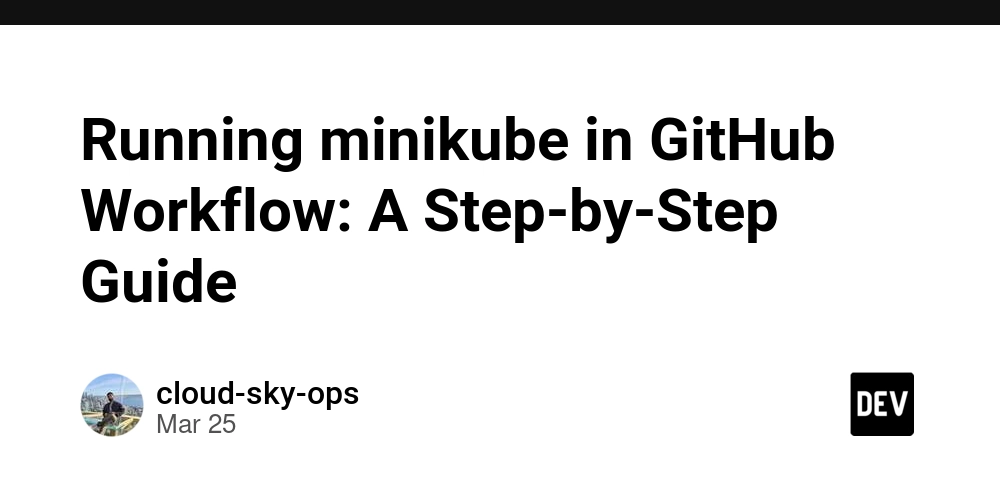Running minikube in GitHub Workflow: A Step-by-Step Guide
Introduction Minikube is a great way to run Kubernetes locally, but ever wondered how to use it inside a GitHub Actions workflow? Running Minikube in CI/CD pipelines can be tricky, but thanks to a GitHub Marketplace action mentioned ahead, we can seamlessly deploy and test containerized applications in Minikube as part of an automated workflow. Why Use Minikube in GitHub Actions? ✅ Run lightweight Kubernetes clusters on pre-defined events ✅ Test Kubernetes manifests before pushing to production ✅ Debug issues in a controlled Minikube environment ✅ Visibility and log access to all team members By integrating Minikube in GitHub Actions, you ensure that your Kubernetes deployments work flawlessly before merging changes. Challenges & workarounds Installing Minikube & Dependencies Installing Minikube manually along with its dependencies (conntrack, iptables, socat, cri-dockerd, etc.) is complex. So instead, switch to using a pre-built Minikube action from the GitHub Marketplace: - name: Start minikube uses: medyagh/setup-minikube@latest ✅ Fix: The official action, medyagh/setup-minikube, handles everything, eliminating manual installation errors. Loading Docker Images into Minikube Minikube runs in an isolated environment, so we must manually load our built Docker image: - name: Load image to minikube run: minikube image load ✅ Fix: minikube image load ensures the image is available inside the Minikube cluster. You can verify using the "minikube image ls" command. ** Using medyagh/setup-minikube GitHub Action** Instead of manually installing Minikube and its dependencies, we can use medyagh/setup-minikube, an official GitHub Action that simplifies Minikube setup. (Minikube documentation) Benefits of medyagh/setup-minikube Quick Minikube installation with minimal setup. Customizable Kubernetes versions, CPU, and memory configurations. Supports multiple drivers (docker, none, etc.) for different environments. Easier debugging and reliability within GitHub runners. Customization Options The medyagh/setup-minikube action provides several configuration options: Parameter Description minikube-version Specifies the Minikube version to install. driver Defines the virtualization driver (e.g., docker, none). container-runtime Sets the container runtime (docker, containerd). kubernetes-version Specifies the Kubernetes version to deploy. cpus Allocates the number of CPUs for the Minikube VM. memory Allocates memory for Minikube. addons Enables Minikube addons like ingress, dashboard. extra-config Allows additional configurations for Kubernetes components. wait Ensures Minikube is fully ready before proceeding. Example Usage - name: Start Minikube uses: medyagh/setup-minikube@latest with: minikube-version: '1.34.0' driver: 'docker' container-runtime: 'containerd' kubernetes-version: 'v1.32.0' cpus: '4' memory: '4000m' addons: 'ingress,dashboard' This sets up Minikube v1.34.0 using the Docker driver, 4 CPUs, 4GB RAM, and enables Ingress & Dashboard addons. Best Practices for Running Minikube in GitHub Actions ✅ Use a pre-built GitHub Action for Minikube instead of manual installation. ✅ Load Docker images using **minikube image load** to make them available in the cluster. ✅ Add logs & debugging steps (kubectl get all, kubectl describe pod, kubectl logs). ✅ Use *workflow_dispatch* and *push* triggers to control when the workflow runs.

Introduction
Minikube is a great way to run Kubernetes locally, but ever wondered how to use it inside a GitHub Actions workflow? Running Minikube in CI/CD pipelines can be tricky, but thanks to a GitHub Marketplace action mentioned ahead, we can seamlessly deploy and test containerized applications in Minikube as part of an automated workflow.
Why Use Minikube in GitHub Actions?
✅ Run lightweight Kubernetes clusters on pre-defined events
✅ Test Kubernetes manifests before pushing to production
✅ Debug issues in a controlled Minikube environment
✅ Visibility and log access to all team members
By integrating Minikube in GitHub Actions, you ensure that your Kubernetes deployments work flawlessly before merging changes.
Challenges & workarounds
Installing Minikube & Dependencies
Installing Minikube manually along with its dependencies (conntrack, iptables, socat, cri-dockerd, etc.) is complex. So instead, switch to using a pre-built Minikube action from the GitHub Marketplace:
- name: Start minikube
uses: medyagh/setup-minikube@latest
✅ Fix: The official action, medyagh/setup-minikube, handles everything, eliminating manual installation errors.
Loading Docker Images into Minikube
Minikube runs in an isolated environment, so we must manually load our built Docker image:
- name: Load image to minikube
run: minikube image load ✅ Fix: minikube image load ensures the image is available inside the Minikube cluster. You can verify using the "minikube image ls" command.
** Using medyagh/setup-minikube GitHub Action**
Instead of manually installing Minikube and its dependencies, we can use medyagh/setup-minikube, an official GitHub Action that simplifies Minikube setup. (Minikube documentation)
Benefits of medyagh/setup-minikube
- Quick Minikube installation with minimal setup.
- Customizable Kubernetes versions, CPU, and memory configurations.
-
Supports multiple drivers (
docker,none, etc.) for different environments. - Easier debugging and reliability within GitHub runners.
Customization Options
The medyagh/setup-minikube action provides several configuration options:
| Parameter | Description |
|---|---|
minikube-version |
Specifies the Minikube version to install. |
driver |
Defines the virtualization driver (e.g., docker, none). |
container-runtime |
Sets the container runtime (docker, containerd). |
kubernetes-version |
Specifies the Kubernetes version to deploy. |
cpus |
Allocates the number of CPUs for the Minikube VM. |
memory |
Allocates memory for Minikube. |
addons |
Enables Minikube addons like ingress, dashboard. |
extra-config |
Allows additional configurations for Kubernetes components. |
wait |
Ensures Minikube is fully ready before proceeding. |
Example Usage
- name: Start Minikube
uses: medyagh/setup-minikube@latest
with:
minikube-version: '1.34.0'
driver: 'docker'
container-runtime: 'containerd'
kubernetes-version: 'v1.32.0'
cpus: '4'
memory: '4000m'
addons: 'ingress,dashboard'
This sets up Minikube v1.34.0 using the Docker driver, 4 CPUs, 4GB RAM, and enables Ingress & Dashboard addons.
Best Practices for Running Minikube in GitHub Actions
✅ Use a pre-built GitHub Action for Minikube instead of manual installation.
✅ Load Docker images using **minikube image load** to make them available in the cluster.
✅ Add logs & debugging steps (kubectl get all, kubectl describe pod, kubectl logs).
✅ Use *workflow_dispatch* and *push* triggers to control when the workflow runs.









































































































































































![[The AI Show Episode 142]: ChatGPT’s New Image Generator, Studio Ghibli Craze and Backlash, Gemini 2.5, OpenAI Academy, 4o Updates, Vibe Marketing & xAI Acquires X](https://www.marketingaiinstitute.com/hubfs/ep%20142%20cover.png)


























































































































![[FREE EBOOKS] The Kubernetes Bible, The Ultimate Linux Shell Scripting Guide & Four More Best Selling Titles](https://www.javacodegeeks.com/wp-content/uploads/2012/12/jcg-logo.jpg)



![From drop-out to software architect with Jason Lengstorf [Podcast #167]](https://cdn.hashnode.com/res/hashnode/image/upload/v1743796461357/f3d19cd7-e6f5-4d7c-8bfc-eb974bc8da68.png?#)







































































































.png?#)




.jpg?#)




















 (1).webp?#)











_Christophe_Coat_Alamy.jpg?#)








































































































![Rapidus in Talks With Apple as It Accelerates Toward 2nm Chip Production [Report]](https://www.iclarified.com/images/news/96937/96937/96937-640.jpg)








































































































































